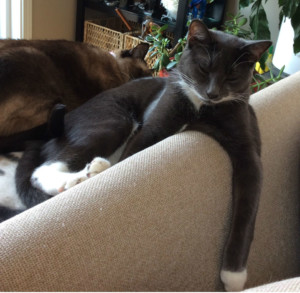Could This Be The Real Thing That’s Keeping You From Saving More Money?
October 25, 2017Scene: Pet store, just before Halloween.
You walk in and the first thing you see is that all pet costumes are 40% off. Of course you stop to look, and ohmygosh, that princess costume is exactly what your Siamese cat needs because come on, she’s the most royal of them all. It wouldn’t be fair to just dress her up, so you also pick out a Jester costume for the kitten, which is actually kind of purrfect since he’s constantly annoying her while she’s holding court.

You move along to the next display and see that they also have Christmas collars and who doesn’t want their cats to be dressed up for the family photo?
And just like that, I went from buying a bag of cat food to (almost) spending $75 on impulse buys that I absolutely, 100%, would have regretted within a week.

Sound familiar?
Each item on its own didn’t seem like much (although $25 is actually a lot of money for a cat costume, now that I’ve left the store and regained my rational mind), but this is how retailers snag your dollars. They KNOW that you’ll be drawn to those displays and they know that you’ll already be adding up the social media likes and comments before you even hit the register.

While saving up for life’s events like weddings, holidays and other fun times is one key to avoiding that infamous “borrowing” from your savings (I used to do it too, I kept a running tally of what I took out of my savings thinking that some day I’d pay it all back, when like what, I won the lottery? I was kidding myself), reinforcing your wallet against impulse spending on stuff is another important key for many of us.
Ideas to overcome the impulse
I won’t insult anyone by suggesting you just stay away from Target or only shop with a list (although that works for some), but if you also find yourself spreeing away your extra dollars, try one of these methods to see if you can’t keep it in check.
- Eliminate the extra cash from your checking account. There’s a reason that happy hour is always busier on payday — everyone feels richer due to the buoyed balance in their checking account. Psychologically, I know that I feel much more spend-y when I have some wiggle room in my account, but if the balance is getting down there, I instinctively think twice about spending on anything beyond planned purchases. Hack your own habit by transferring any money you’re not planning to spend on bills and other planned expenditures before your next paycheck to a separate savings account. You may need to dip into it when things come up you didn’t anticipate, but it may make you think twice the next time a shiny object catches your eye.
- Give yourself a splurge budget. Whether that’s factoring in that you can’t get out of Target without spending $100, or keeping an extra fifty dollar bill in your wallet that only gets replenished on the first of the month, allowing yourself to partake in the impulse spending — but in a more mindful way — can help to keep it in check.
- Remember what you’re saying no to by saying yes to the dress/scarf/tote bag/cat costume. This is the trick I used that had me putting the cat clothes back — I somehow had the presence of mind to remind myself that the more money I save today, the earlier I can retire or the more fantastic vacation we can go on next year. Maybe put a post-it note on your credit card or some other physical blocker that can take you out of your emotional/impulsive mind and back to your rational head.
- Match your splurge. Make a rule that for every dollar you spend on an impulse buy you will match with a dollar to savings.
- Save your savings. If you’re a sucker for a flash sale or love looking at the bottom of your receipt to see how much you saved at discount stores like Marshalls or TJ Maxx, make a commitment to actually save that money by pulling up your banking app on the spot and moving the “savings” amount into your actual savings account.
- Put yourself on a temporary spending diet. One way to deal with the fact that impulse buying is our emotional mind overcoming our rational mind is to create a habit, which takes practice. I’ve lost count of how many food diets I’ve tried and while I may stray from the eating plans after approximately 11 days, some of the habits stick over time. For example, now that I know how much sugar is in a pumpkin spice latte, I’ve gone cold turkey even if I do pop into Starbucks for a treat on occasion — I just choose a lower sugar option. By committing to NOT impulse buy for, say, 21 days (the length of time many experts say it takes to create a habit), you may naturally quell the impulse even if you go off your “diet.”
- Create an email filter for all retail emails to skip your inbox and go straight to a folder. This way you can still get the coupons if you need them, but without the daily nudges to shop. This is another trick I actively use and here’s how I know it works: If I know I need to go to Michael’s to buy something, I look in my “Shopping” email folder to see whatever coupon or offer they emailed me that day, but otherwise I’m not tempted because I don’t see it in my inbox. On the other hand, a few weeks ago, an Athleta email escaped the filter and within minutes of opening the email I found myself pages deep in yoga pants and sweater dresses. Danger zone!
What ways have you found that keep your impulse buying in check? I’d love to know and share them in a future post! You can email them to me or just comment on this article on our Facebook page.
